Eight-thousander

 Clash Royale CLAN TAG#URR8PPP
Clash Royale CLAN TAG#URR8PPP

Locations of the 14 eight-thousanders in the world
The International Mountaineering and Climbing Federation or UIAA recognise eight-thousanders as the 14 mountains that are more than 8,000 metres (26,247 ft) in height above sea level, and are considered to be sufficiently independent from neighbouring peaks. However, there is no precise definition of the criteria used to assess independence and since 2012, the UIAA has been involved in a process to consider whether the list should be expanded to 20 mountains. All eight-thousanders are located in the Himalayan and Karakoram mountain ranges in Asia, and their summits are in the death zone.
Contents
1 History of climbing all eight-thousanders
2 Proposed expansion of list
3 List of all 14 eight-thousanders
4 Climbers of all 14 eight-thousanders
4.1 Climbers with verified ascents
4.2 Climbers with disputed ascents
5 Image gallery
6 See also
7 Notes
8 References
9 External links
History of climbing all eight-thousanders

Flight over Khumbu-region; six eight-thousanders and some seven-thousanders are visible
The first recorded attempt on an eight-thousander was when Albert F. Mummery and J. Norman Collie tried to climb Pakistan's Nanga Parbat in 1895. The attempt was unsuccessful when Mummery and two Gurkhas, Ragobir, and Goman Singh, were killed by an avalanche.[1]
The first recorded successful ascent of an eight-thousander was by the French Maurice Herzog and Louis Lachenal, who on the 1950 French Annapurna expedition reached the summit of Annapurna on 3 June 1950.[2] The first winter ascent of an eight-thousander was done by a Polish team led by Andrzej Zawada on Mount Everest. Two
climbers Leszek Cichy and Krzysztof Wielicki reached the summit on 17 February 1980.[3]
The first person to climb all 14 eight-thousanders was the Italian Reinhold Messner, on 16 October 1986. In 1987, Polish climber Jerzy Kukuczka became the second person to accomplish this feat. Kukuczka is also the man who established the most new routes (9) on the main eight-thousanders. Messner summited each of the 14 peaks without the aid of supplemental oxygen. This feat was not repeated until nine years later by the Swiss Erhard Loretan in 1995. Phurba Tashi of Nepal has completed the most climbs of the eight-thousanders, with 30 ascents between 1998 and 2011.[4]Juanito Oiarzabal has completed the second most, with a total of 25 ascents between 1985 and 2011.[5]
The Italian Simone Moro made the most first winter ascents of eight-thousanders (4); Jerzy Kukuczka made four winter ascents as well, but one was a repetition. As of November 2018[update], K2 remains the only eight-thousander that has never been summited in the winter.[6]

The 30 highest peaks above 500 m prominence
In 2010, Spanish climber Edurne Pasaban, became the first woman to summit all 14 eight-thousanders with no disputed climbing.[7] In August 2011, Austrian climber Gerlinde Kaltenbrunner became the first woman to climb the 14 eight-thousanders without the use of supplementary oxygen.[8][9]
The first couple and team who summited all 14 eight-thousanders together were the Italians Nives Meroi (second woman without supplementary oxygen), and her husband Romano Benet in 2017. They climbed in alpine style, without the use of supplementary oxygen.[10]
As of November 2018[update], the country with the most climbers to have climbed all 14 eight-thousanders is Italy with seven climbers, followed by Spain with six climbers, and South Korea with five climbers. Kazakhstan and Poland have three climbers each that completed the "Crown of the Himalaya".
Proposed expansion of list

Deaths above base camp on eight-thousanders (1950 to March 2012).[11]
In 2012, to relieve capacity pressure,[12] and develop climbing tourism, Nepal lobbied the International Climbing and Mountaineering Federation (or UIAA) to reclassify 5 summits (2 on Lhotse and 3 on Kanchenjunga), as standalone eight-thousanders, while Pakistan lobbied for a sixth summit (on Broad Peak)[13] In 2012, the UIAA set up a project group to consider the proposals called the AGURA Project.[13] The 6 proposed summits for reclassification are subsidiary-summits of existing eight-thousanders, but which are also themselves above 8,000 metres and have a prominence above 60 metres.
Proposed to the UIAA in 2012 for reclassification as standalone eight-thousanders.[13]
| Proposed new eight-thousander | Height (m) | Prominence (m) | Dominance (Prom / Height)[15] | Dominance classification[15] |
|---|---|---|---|---|
| Broad Peak Central | 8011 | 181 | 2,26 | B2 |
| Kangchenjunga W-Peak (Yalung Kang) | 8505 | 135 | 1,59 | C1 |
| Kangchenjunga S-Peak | 8476 | 116 | 1,37 | C2 |
| Kangchenjunga C-Peak | 8473 | 63 | 0,74 | C2 |
| Lhotse C-Peak I | 8410 | 65 | 0,77 | C2 |
| Lhotse Shar | 8382 | 72 | 0,86 | C2 |
| K 2 SW-Peak | 8580 | 30 | 0,35 | D1 |
| Lhotse C-Peak II | 8372 | 37 | 0,44 | D1 |
| Everest W-Peak | 8296 | 30 | 0,36 | D1 |
| Yalung Kang Shoulder | 8200 | 40 | 0,49 | D1 |
| Kangchenjunga SE-Peak | 8150 | 30 | 0,37 | D1 |
| K 2 P. 8134 (SW-Ridge) | 8134 | 35 | 0,43 | D1 |
| Annapurna C-Peak | 8013 | 49 | 0,61 | D1 |
| Nanga Parbat S-Peak | 8042 | 30 | 0,37 | D1 |
| Annapurna E-Peak | 7986 | 65 | 0,81 | C2 |
| Shisha Pangma C-Peak | 8008 | 30 | 0,37 | D1 |
| Everest NE-Shoulder | 8423 | 19 | 0,23 | D2 |
| Everest NE-Pinnacle III | 8383 | 13 | 0,16 | D2 |
| Lhotse N-Pinnacle III | 8327 | 10 | 0,12 | D2 |
| Lhotse N-Pinnacle II | 8307 | 12 | 0,14 | D2 |
| Lhotse N-Pinnacle I | 8290 | 10 | 0,12 | D2 |
| Everest NE-Pinnacle II | 8282 | 25 | 0,30 | D2 |
The proposed 6 new eight-thousander peaks would not meet the wider UIAA criteria of 600 meters of elevation change between standalone peaks, called topographic prominence, as used by the UIAA elsewhere for major mountains (the lowest prominence of the existing list of 14 eight-thousanders is Lothse, at 610 metres).[16][17] For example, only Broad Peak Central, with a topographic prominence of 181 meters, would even meet the 150–metre prominence threshold to be a British Isles Marilyn.[16] However, the appeal noted the UIAA's 1994 reclassification of Alpine 4,000 metre peaks where a prominence threshold of 30–metres was used, amongst other criteria; the logic being that if 30–metres worked for 4,000 metres summits, then 60–metres should work for 8,000m summits.[18]
As of November 2018[update], there has been no conclusion by the UIAA and the proposals appear to have been set aside.
List of all 14 eight-thousanders
| Mountain[19] | First ascent[19] | First winter ascent[19] | From 1950 to March 2012[11] | Climber Death Rate[20][21][a] | ||||||
|---|---|---|---|---|---|---|---|---|---|---|
| Peak | Height | Location | Date | Summiter(s) | Date | Summiter(s) | Total Ascents[b] | Total Deaths[c] | Deaths / Ascents[d] | |
Everest | 8848 m 29,029 ft | 29 May 1953 |
| 17 February 1980 | 5656 | 223 | 3.9% | 1.52% | ||
K2 | 8611 m 28,251 ft | 31 July 1954 | 306 | 81 | 26.5% | –[e] | ||||
Kangchenjunga | 8586 m 28,169 ft | 25 May 1955 | 11 January 1986 | 283 | 40 | 14.1% | 3.00% | |||
Lhotse | 8516 m 27,940 ft | 18 May 1956 | 31 December 1988 | 461 | 13 | 2.8% | 1.03% | |||
Makalu | 8485 m 27,838 ft | 15 May 1955 | 9 February 2009 | 361 | 31 | 8.6% | 1.63% | |||
Cho Oyu | 8201 m 26,906 ft | 19 October 1954 | 12 February 1985 | 3138 | 44 | 1.4% | 0.64% | |||
Dhaulagiri I | 8167 m 26,795 ft | 13 May 1960 | 21 January 1985 | 448 | 69 | 15.4% | 2.94% | |||
Manaslu | 8163 m 26,781 ft | 9 May 1956 | 12 January 1984 | 661 | 65 | 9.8% | 2.77% | |||
Nanga Parbat | 8126 m 26,660 ft | 3 July 1953 | 26 February 2016 | 335 | 68 | 20.3% | –[e] | |||
Annapurna I | 8091 m 26,545 ft | 3 June 1950 | 3 February 1987 | 191 | 61 | 31.9% | 4.05% | |||
Gasherbrum I (Hidden Peak) | 8080 m 26,444 ft | 5 July 1958 | 9 March 2012 | 334 | 29 | 8.7% | –[e] | |||
Broad Peak | 8051 m 26,414 ft | 9 June 1957 | 5 March 2013 | 404 | 21 | 5.2% | –[e] | |||
Gasherbrum II | 8035 m 26,362 ft | 7 July 1956 | 2 February 2011 | 930 | 21 | 2.3% | –[e] | |||
Shishapangma | 8027 m 26,335 ft | 2 May 1964 | 14 January 2005 | 302 | 25 | 8.3% | –[e] | |||
Climbers of all 14 eight-thousanders
There is no single undisputed source for verified Himalayan ascents, however, Elizabeth Hawley's The Himalayan Database,[25] is considered as an important source for the Nepalese Himalayas.[26][27] Online ascent databases pay close regard to The Himalayan Database, including the website AdventureStats.com,[28] and the Eberhard Jurgalski List.[29] Various mountaineering journals (including the Alpine Journal and the American Alpine Journal), maintain extensive records and archives but do not always opine on ascents.
Climbers with verified ascents

Reinhold Messner, first to climb all 14 eight-thousanders, and first to do so without supplementary Oxygen

Edurne Pasaban, first woman to climb all 14 eight-thousanders
The "No O2" column lists people who have climbed all 14 eight-thousanders without any bottled, or supplementary, oxygen.
| Order | Order (No O2) | Name | Period | Born | Age | Nationality |
|---|---|---|---|---|---|---|
| 1 | 1 | Reinhold Messner | 1970–1986 | 1944 | 42 | |
| 2 | Jerzy Kukuczka | 1979–1987 (deceased) | 1948 | 39 | ||
| 3 | 2 | Erhard Loretan | 1982–1995 (deceased) | 1959 | 36 | |
| 4 | [31] | Carlos Carsolio | 1985–1996 | 1962 | 33 | |
| 5 | Krzysztof Wielicki | 1980–1996 | 1950 | 46 | ||
| 6 | 3 | Juanito Oiarzabal | 1985–1999 | 1956 | 43 | |
| 7 | Sergio Martini | 1983–2000 | 1949 | 51 | ||
| 8 | Young-Seok Park | 1993–2001 (deceased)[32] | 1963 | 38 | ||
| 9 | Hong-Gil Um | 1988–2001 | 1960[33] | 40 | ||
| 10 | 4 | Alberto Iñurrategi | 1991-2002[34] | 1968 | 33 | |
| 11 | Wang-Yong Han | 1994–2003 | 1966 | 37 | ||
| 12 | 5[35] | Ed Viesturs | 1989–2005 | 1959 | 46 | |
| 13 | 6[36][37][38] | Silvio Mondinelli | 1993–2007 | 1958 | 49 | |
| 14 | 7[39] | Ivan Vallejo | 1997–2008 | 1959 | 49 | |
| 15 | 8[40] | Denis Urubko | 2000–2009 | 1973 | 35 | |
| 16 | Ralf Dujmovits | 1990–2009 | 1961[41] | 47 | ||
| 17 | 9 | Veikka Gustafsson | 1993–2009 | 1968 | 41 | |
| 18[42] | Andrew Lock | 1993–2009 | 1961[43] | 48 | ||
| 19 | 10 | João Garcia | 1993–2010 | 1967 | 43 | |
| 20[44] | Piotr Pustelnik | 1990–2010 | 1951 | 58 | ||
| 21[45] | Edurne Pasaban | 2001–2010 | 1973 | 36 | ||
| 22[46] | Abele Blanc | 1992–2011[47][48] | 1954 | 56 | ||
| 23 | Mingma Sherpa | 2000–2011[47] | 1978 | 33 | ||
| 24 | 11 | Gerlinde Kaltenbrunner | 1998–2011[47] | 1970 | 40 | |
| 25 | Vassily Pivtsov | 2001–2011[47] | 1975 | 36 | ||
| 26 | 12 | Maxut Zhumayev | 2001–2011[47] | 1977 | 34 | |
| 27 | Jae-Soo Kim | 2000–2011[47] | 1961 | 50 | ||
| 28[49] | 13 | Mario Panzeri | 1988–2012 | 1964 | 48 | |
| 29[50] | Hirotaka Takeuchi | 1995–2012[50] | 1971 | 41 | ||
| 30 | Chhang Dawa Sherpa | 2001–2013[47] | 1982 | 30 | ||
| 31 | 14 | Kim Chang-Ho | 2005–2013[47] (deceased) | 1970 | 43 | |
| 32 | Jorge Egocheaga | 2002–2014[51] | 1968 | 45 | ||
| 33 | 15 | Radek Jaroš | 1998–2014[47] | 1964 | 50 | |
| 34/35[52] | 16/17[52] | Nives Meroi | 1998–2017[53][54] | 1961 | 55 | |
| 34/35[52] | 16/17[52] | Romano Benet | 1998–2017[53][54][55] | 1962 | 55 | |
| 36 | Peter Hámor | 1998–2017[56] | 1964 | 52 | ||
| 37 | 18 | Azim Gheychisaz | 2008–2017[57] | 1981 | 37 | |
| 38 | Ferran Latorre | 1999–2017[58] | 1970 | 46 | ||
| 39 | 19 | Òscar Cadiach | 1984–2017[59] | 1952 | 64 | |
| 40 | Zhang Liang | 2000-2018[60] | 1964 | 54 |
Climbers with disputed ascents
Claims in which not enough evidence was provided to verify the ascents of all 14 peaks. The disputed ascent in each claim is shown in parentheses. In most cases, the influential Himalayan chronicler Elizabeth Hawley, is an important source regarding the fact-base of the dispute. Her well-regarded The Himalayan Database is the source for other online Himalayan ascent databases (e.g. AdventureStats.com).[26][27]
Cho Oyu is a recurrent problem peak as it is a small hump circa 30 mins into the summit plateau, and the main proxy - "Did you see Everest" - requires clear weather.[61][62]Shishapangma is another problem peak because of its dual summits, which despite being close in height, are up to two hours climbing time apart.[63]Elizabeth Hawley famously got Ed Viesturs to re-climb the main summit of Shishapangma.[64]
| Name | Period | Born | Age | Nationality |
|---|---|---|---|---|
Fausto De Stefani (Lhotse 1997)[65] (His partner Sergio Martini reclimbed Lhotse in 2000 to verify his 14, see above) | 1983–1998 | 1952 | 46 | |
Alan Hinkes (Cho Oyu 1990)[66][67] (Hinkes rejects Hawley's decision to "unrecognise" his Cho Oyu ascent, see "Cho Oyu dispute") | 1987–2005 | 1954 | 53 | |
Vladislav Terzyul (Shishapangma (West) Summit 2000, Broad Peak 1995[68][69])[70][71] (As he did not claim the main summit of Shishapangma, this status is unlikely to change) | 1993–2004 (deceased) | 1953 | 49 | |
Eun-Sun Oh (Kangchenjunga 2009)[72][73][74] (As the potential first female climber of all 14, this dispute was followed internationally)[73] | 1997–2010 | 1966 | 44 | |
Carlos Pauner (Shishapangma 2012)[75] (Pauner is very open about his uncertainty as it was dark, but says he might reclimb to remove the doubt)[76] | 2001–2013 | 1963 | 50 |
Image gallery

No. 1 – Everest

No. 2 – K2
No. 3 – Kangchenjunga

No. 4 – Lhotse

No. 5 – Makalu

No. 6 – Cho Oyu
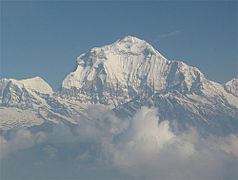
No. 7 – Dhaulagiri

No. 8 – Manaslu
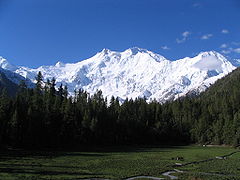
No. 9 – Nanga Parbat

No. 10 – Annapurna
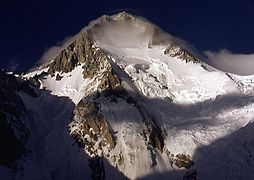
No. 11 – Gasherbrum I

No. 12 – Broad Peak
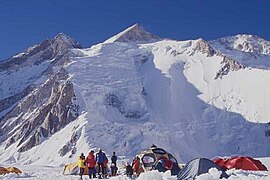
No. 13 – Gasherbrum II
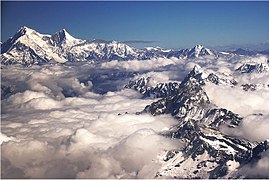
No. 14 – Shishapangma
See also
The Himalayan Database, statistics for the Nepalese Himalaya- List of deaths on eight-thousanders
- List of highest mountains
- List of ski descents of eight-thousanders
- List of Mount Everest summiters by number of times to the summit
Seven Summits, the highest mountain on each continent
Seven Second Summits, the second highest mountain on each continent
Volcanic Seven Summits, the highest volcanos on each continent
Explorers Grand Slam, the North Pole, the South Pole, and the Seven Summits
Three Poles Challenge, the North Pole, the South Pole, and Mount Everest
Notes
^ Per The Himalayan Database (HDB) tables, the Climber (or Member) Death Rate is the ratio of deaths above base camp, of all climbers who were hoping to summit and who went above base camp, for 1950 to 2009, and is closer to a true probability of death; the data is only for Nepalese Himalaya. Summary tables from the HDB report for all mountains above 8,000 metres, imply that the death rate for the period 1990 to 2009 (e.g. modern expeditions), is roughly half that of the combined 1950 to 2009 period.[20]
^ As recorded by Eberhard Jurgalski
^ As recorded by Eberhard Jurgalski and being any death (climber or other) above Base Camp.[22]
^ This should not be mistaken as being a death rate; it does not imply a probabiltiy of death for a climber attempting to climb an eight-thousander as it includes all deaths from all activities undertaken above base camp (e.g. training or reconissance trips, camp stocking activities by porters who will not be summiting the mountain, rescue attempts etc.). It therefore compares deaths from the larger group of people who were, and were not, making a summit attempt, with the smaller group who were making a summit attempt. While it is not a probability, the statistic does reflect the ratio of people who died above base camp for each climber who summited.
^ abcdef Data is not available for the Pakistani Himalayas
References
^
"Fast Facts About Nanga Parbat". climbing.about.com. Retrieved 2015-05-29..mw-parser-output cite.citationfont-style:inherit.mw-parser-output qquotes:"""""""'""'".mw-parser-output code.cs1-codecolor:inherit;background:inherit;border:inherit;padding:inherit.mw-parser-output .cs1-lock-free abackground:url("//upload.wikimedia.org/wikipedia/commons/thumb/6/65/Lock-green.svg/9px-Lock-green.svg.png")no-repeat;background-position:right .1em center.mw-parser-output .cs1-lock-limited a,.mw-parser-output .cs1-lock-registration abackground:url("//upload.wikimedia.org/wikipedia/commons/thumb/d/d6/Lock-gray-alt-2.svg/9px-Lock-gray-alt-2.svg.png")no-repeat;background-position:right .1em center.mw-parser-output .cs1-lock-subscription abackground:url("//upload.wikimedia.org/wikipedia/commons/thumb/a/aa/Lock-red-alt-2.svg/9px-Lock-red-alt-2.svg.png")no-repeat;background-position:right .1em center.mw-parser-output .cs1-subscription,.mw-parser-output .cs1-registrationcolor:#555.mw-parser-output .cs1-subscription span,.mw-parser-output .cs1-registration spanborder-bottom:1px dotted;cursor:help.mw-parser-output .cs1-hidden-errordisplay:none;font-size:100%.mw-parser-output .cs1-visible-errorfont-size:100%.mw-parser-output .cs1-subscription,.mw-parser-output .cs1-registration,.mw-parser-output .cs1-formatfont-size:95%.mw-parser-output .cs1-kern-left,.mw-parser-output .cs1-kern-wl-leftpadding-left:0.2em.mw-parser-output .cs1-kern-right,.mw-parser-output .cs1-kern-wl-rightpadding-right:0.2em
^
Herzog, Maurice (1951). Annapurna: First Conquest of an 8000-meter Peak. Translated from the French by Nea Morin and Janet Adam Smith. New York: E.P Dutton & Co. p. 257.
^ https://www.alpinejournal.org.uk/Contents/Contents_1984_files/AJ%201984%2050-59%20Zawada%20Everest.pdf
^ "Preliminary stats: Himalaya and Everest 2011 spring review". ExplorersWeb. 8 June 2013. Retrieved 2014-01-04. (Subscription required (help)).
^ "Lhotse Summits". 8000ers.com. Retrieved 2014-01-04.
^ Planetmountain.com, Nanga Parbat: summit and first winter ascent by Simone Moro, Ali Sadpara and Alex Txikon, 26 February 2016
^ "Oh Eun-Sun report, final: Edurne Pasaban takes the throne". ExplorersWeb. 10 December 2010. Retrieved 2014-01-04. (Subscription required (help)).
^ "Austrian woman claims Himalayas climbing record". BBC News. 23 August 2011. Retrieved 2011-08-24.
^ "Austrian is first woman to scale 14 peaks without oxygen". AsiaOne. 30 August 2011. Retrieved 2014-01-04.
^ "Alpinismo, il record di Meroi-Benet: è italiana la prima coppia su tutti gli Ottomila". 11 May 2017.
^ abc "DAILY CHART: Stairway to heaven, how deadly are the world's highest mountains?". The Economist. 29 March 2013.For every three thrill-seekers that make it safely up and down Annapurna I, one dies trying, according to data from Eberhard Jurgalski of website 8000ers.com, collected in his forthcoming book "On Top of the World: The New Millennium", co-authored by Richard Sale.
^ Richard Gray (23 August 2013). "The new peaks opened as alternatives to Mount Everest". The Telegraph.Nepal is to tackle overcrowding on the world’s highest mountain by placing greater restrictions on expeditions to the summit of Mount Everest. The move is a response to growing problems with litter, pollution and recent clashes between Sherpas and Western climbers. But in an attempt to appease those hoping to conquer the 29,029 feet tall peak, the Nepalese government is to open access to five other summits that sit over 26,246 feet, or 8,000 meters.
^ abc Navin Singh Khadka (18 October 2013). "Nepal mountain peak expansion bid stalls". BBC News.The UIAA initiated in 2012 what it calls the ARUGA project with an aim to see if new 8,000m-plus could feasibly achieve international recognition. Under that project, Nepal had tabled five new peaks and Pakistan one.
^ Eberhard Jurgalski. "Subsidiary Peaks". 8000ers.com. Retrieved 23 November 2018.There are several different subsidiary peaks! Here are the geographical facts, from the one "relative independent Main-Peak" (EU category B) over the important subsidiary peaks (C) to the major notable points (D1) Especially the last category is just guessed by contours or from photographs.
^ ab Eberhard Jurgalski. "Dominance". 8000ers.com. Retrieved 23 November 2018.Accordingly, the author introduced altitude classes (AC) and a proportional prominence, which he named orometrical dominance (D). D is calculated easily but fittingly: (P/Alt) x 100. Thus, it indicates the percentage of independence for every elevation, no matter what the altitude, prominence or mountain type it is. From a scientific point of view, altitude could be seen as the thesis, prominence as the antithesis, whereas dominance would be the synthesis.
^ ab "Do we really need more 8000m peaks". Mark Horrell. 23 October 2013.The most prominent one, Broad Peak Central is just 196m high and the least prominent, Lhotse Middle, is a meagre 60m. To put this in context, the highest mountain in Malta is 253m, while the Eiffel Tower stands a whopping 300m.
^ "A funny name for a mountain". Mark Horrell. 4 June 2014.
^ "UIAA Mountain Classification: 4,000ERS OF THE ALPS". UIAA. March 1994.Topographic criterium: for each summit, the level difference between it and the highest adjacent pass or notch should be at least 30 m (calculated as average of the summits at the limit of acceptability). An additional criterium can be the horizontal distance between a summit and the base of another adjacent 4000er.
^ abcd Eberhard Jurgalski. "General Info". 8000ers.com. Retrieved 2014-02-21.
^ ab Elizabeth Hawley; Richard Sailsbury (2011). "The Himalaya by the Numbers: A Statistical Analysis of Mountaineering in the Nepal Himalaya" (PDF). p. 129.Table D-3: Deaths for peaks with more than 750 members above base camp from 1950-2009
^ "Himalayan Death Tolls". The Washington Post. 24 April 2014.
^ Eberhard Jurgalski. "Fatalities tables". 8000ers.com. Retrieved 23 November 2018.Included are only fatalities from, at or above BC or caused from there. Fatalities on approach or return marches are not listed.
^ "K2 lies in Pakistan, near the northern border with China". BBC News.
^ Harding, Luke (13 July 2000). "Climbers banned from sacred peak". the Guardian. Retrieved 29 March 2018.
^ Elizabeth Hawley; Richard Salisbury (2018). "The Himalayan Database, The Expedition Archives of Elizabeth Hawley". The Himalayan Database.
^ ab If a mountaineer wants worldwide recognition that they have reached the summit of some of the most formidable mountains in the world, they will need to get the approval of Elizabeth Hawley."Elizabeth Hawley, unrivalled Himalayan record keeper". BBC News. 29 August 2010.
^ ab "Elizabeth Hawley, Who Chronicled Everest Treks, Dies at 94". New York Times. 26 January 2018.
^ "High Altitude Mountaineering statistics". AdventureStats.com. 2018.
^ "Climbers who have ascended to the summits of all of the world's 14 mountains over 8000 metres". 8000ers.com (Eberhard Jurgalski). 2018.
^ Eberhard Jurgalski (26 May 2012). "Climbers - First 14". 8000ers.com. Retrieved 2014-02-21.
^ Carlos Carsolio required emergency oxygen on his descent from Makalu in 1988.
^ Coley, Mariah. "Koreans Missing on Annapurna Presumed Dead". Alpinist.com. Retrieved 9 November 2011.
^
EverestNews2004.com, News (age calculated: in 2004 Hong-Gil Um was 44). "Mr. Um Hong Gil has bagged his 15th 8000 meter peak". Retrieved 2008-11-30.
^
Kukuxumusu, Spanish News. "Alberto Iñurrategi achieves his fourteenth "eight thousand meters"". Retrieved 2008-11-30.
^
"Best of ExplorersWeb 2005 Awards: Ed Viesturs and Christian Kuntner". Mounteverest.net. Retrieved 2008-11-30....the American climber became one of only five men in the world to accomplish the quest entirely without supplementary oxygen.
^
Mounteverest.net. "The wolf is back: Gnaro bags Baruntse". Retrieved 2008-11-30.Last year, Silvio 'Gnaro' Mondinelli broke the haunted 13 when he summited the last peak on his list of 14, 8000ers - becoming only the 6th mountaineer in the world to have bagged them all without supplementary oxygen.
^
"The day after: Silvio Mondinelli, Broad Peak and all 14 8000m summits". PlanetMountain.com. Retrieved 2008-11-30.13/07 interview with Silvio Mondinelli after the summit of his 14th 8000m peak without supplementary oxygen.
^
"The 14th knight: Ecuadorian Ivan Vallejo is ready to continue". Mounteverest.net. Retrieved 2008-11-30.Implied in text: ...Following Italian Silvio "Gnaro" Mondinelli last year and American Ed Viesturs in 2005, Ivan also became only the seventh mountaineer in the world to have done them all without supplementary oxygen.
^
"The 14th knight: Ecuadorian Ivan Vallejo is ready to continue". Mounteverest.net. Retrieved 2008-11-30....Ivan also became only the seventh mountaineer in the world to have done them all without supplementary oxygen.
^
"Denis Urubko, Cho Oyu and all 14 8000m peaks". PlanetMountain.com. Retrieved 2009-05-18.
^ "Ralf Dujmovits". Ralf-dujmovits.de. Retrieved 2010-04-14.
^ "Summit 8000 - Andrew Lock's quest to climb all fourteen of the highest mountains in the world". Andrew-lock.com. Retrieved 2010-04-14.
^ "Australia's Most Accomplished Mountaineer". Andrew Lock. 2 October 2009. Retrieved 2010-04-14.
^ "Piotr Pustelnik summits Annapurna - bags the 14x8000ers!". Explorersweb.com. Retrieved 2014-02-21.
^ "Shisha Pangma: Edurne Pasaban summits - completes the 14x800ers". Explorersweb.com. Retrieved 2014-02-21.
^ "Abele Blanc summits Annapurna and all 8000ers". Planetmountain.com. Retrieved 2014-02-21.
^ abcdefghi "Climbers - First 14, updated table on 8000ers.com". 8000ers.com. Retrieved 2014-02-21.
^ "Everest - Mount Everest by climbers, news". Mounteverest.net. 18 May 2005. Retrieved 2014-01-21.
^ "Mario Panzeri: sono in cima! E finalmente sono 14 ottomila". Montagna.tv. Retrieved 2014-02-21.
^ ab "日本人初の快挙、8000m峰14座登頂 竹内洋岳". Nikkei.com. Retrieved 2014-02-21.
^ "Climbers - First 14". 8000ers.com. 13 August 2014. Retrieved 2014-08-13.
^ abcd Nives Meroi and Romano Benet climbed all the Eight-thousanders together, it wasn't revealed if one of them climbed the last peak a few moments before the other, thus they share the same position
^ ab "Nives Meroi and Romano Benet summit Annapurna, their 14th 8000er". PlanetMountain.com. Retrieved 2017-05-11.
^ ab "Nives Meroi in Roman Benet preplezala 14 osemtisočakov". Sta.si (in Slovenian). Retrieved 2017-05-11.
^ "Slovenec s 15. osemtisočaka". Delo.si (in Slovenian). Retrieved 2017-05-11.
^ "Pokoril všetky osemtisícovky". skrsi.rtvs.sk. 16 May 2017. Retrieved 2017-05-17.
^ "قیچیساز حماسه ساز شد/کوهنورد تبریزی به هشت هزاریها پیوست". yjc. 19 May 2017. Retrieved 2017-05-19.
^ "Ferran Latorre completa los catorce ochomiles en el Everest" (in Spanish). desnivel.com. 27 May 2017. Retrieved 2017-05-27.
^ "Cadiach, camino del campo 3 tras coronar el Broad Peak" (in Spanish). La Vanguardia. 27 July 2017. Retrieved 2017-07-27.
^ "China's top mountaineer finds the meaning of life at 26,000 feet". Inkstone. 24 August 2018. Retrieved 2018-09-11.
^ I have summitted Cho Oyu 4 times and will be heading for my fifth this coming season. Each time I have watched the Koreans and Japanese go only to where they can see Everest, not the summit, because they know this is what will be asked."Cho Oyu summit: Where is it exactly". Explorersweb.com. September 2017.
^ Many people who climb Cho Oyu in Tibet stop at a set of prayer flags with views of Everest and believe they’ve reached the top, unaware they still have to walk for 15 minutes across the summit plateau until they can see the Gokyo Lakes in Nepal."When is a summit not a summit?". Mark Horrell. 12 November 2014.
^ "Asia, Tibet, Cho Oyu and Shisha Pangma Central (West) Summit". American Alpine Journal. 1991.
^ "Keeper of the Mountains: The Elizabeth Hawley Story". Rocky Mountain Books. 5 October 2012. pp. 185–195.
^ Elizabeth Hawley (2014). "Seasonal Stories for the Nepalese Himalaya 1985-2014" (PDF). The Himalayan Database. p. 274.But a South Korean climber, who followed in their footprints on the crusted snow three days later [in 1997] in clearer weather, did not consider that they actually gained the top. While [Sergio] Martini and [Fausto] De Stefani indicated they were perhaps only a few meters below it, Park Young-Seok claimed that their footprints stopped well before the top, perhaps 30 meters below a small fore-summit and 150 vertical meters below the highest summit. Now in 2000 [Sergio] Martini was back again, and this time he definitely summited Lhotse.
^ AdventureStats.net, Official records. "Climbers that have summited 10 to 13 of the 14 Main-8000ers". Retrieved 2008-11-30.
^ Elizabeth Hawley (2014). "Seasonal Stories for the Nepalese Himalaya 1985-2014" (PDF). The Himalayan Database. p. 347.But his claim to have now climbed all 8000ers is open to question. In April 1990 he and others reached the summit plateau of Cho Oyu. It was misty so they could not see well; nine years later Hinkes said he had “wandered around for a while” in the summit area but could see very little and eventually descended to join the others, one of whom said they had not reached the top.
^ "Vladislav Terz". www.russianclimb.com. Retrieved 2016-04-28.
^ "AdventureStats - by Explorersweb". www.adventurestats.com. Retrieved 2016-04-28.
^
Russianclimb.com, Mountaineering World of Russia & CIS. "Vladislav Terzyul, List of ascents". Retrieved 2009-10-06.
^ "Sad results on Makalu and Unanswered Questions: 1 missing climber and 1 passed away on Makalu". Everestnews2004.com. Archived from the original on 12 May 2012. Retrieved 2014-02-21.
^ "Everest K2 News ExplorersWeb - More dark clouds mounting on Anna summit push; Miss Oh's Kanchen summit "disputed" after renewed accusations". Explorersweb.com. 26 April 2010. Retrieved 2014-01-21.
^ ab "New doubts over Korean Oh Eun-Sun's climbing record, Hawley to investigate". BBC News. 27 August 2010.
^ What would appear to be the most serious blow to Miss Oh, on 26 August this year the Korean Alpine Federation, the nation's largest climbing association, concluded that Miss Oh had not reached the top of Kangchenjunga."Seasonal Stories for the Nepalese Himalaya 1985-2014" (PDF). Elizabeth Hawley. 2014. p. 394.
^ "Desnivel; Carlos Pauner consigue la cima del Everest". Desnivel.com. Retrieved 2014-01-21.
^ "Carlos Pauner is not sure if they hit the top of the Shisha Pangma (8,027)". lainformacion.com. 18 February 2016.
External links
8000ers.com, a site dedicated to statistics on 8000m peaks and climbs
The Himalayan Database, statistics on Nepalese Himalayan (but not Pakistan Himalaya) climbs from 1905 to 2018- Graphical Interface for The Himalayan Database
AdventureStats.com (High Altitude Mountaineering), a site dedicated to recording adventure statistics- NASA Earth Observatory: The Eight-Thousanders














